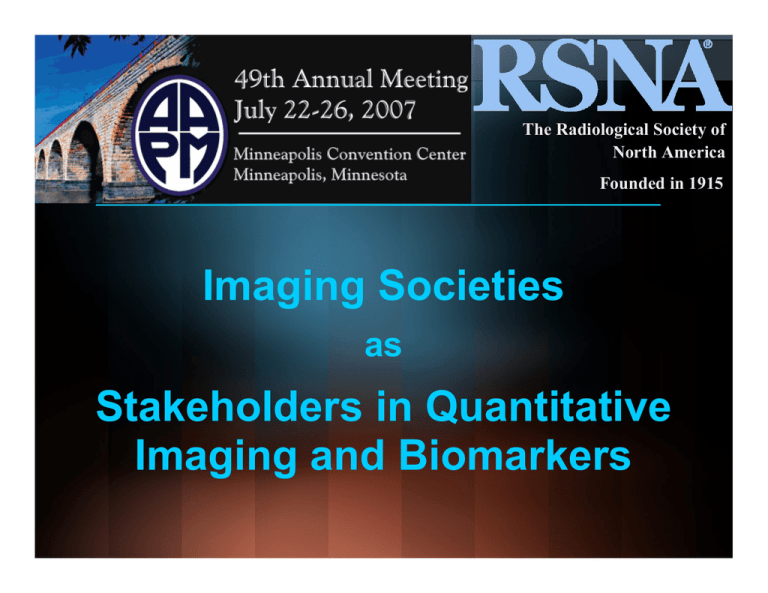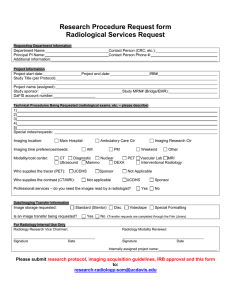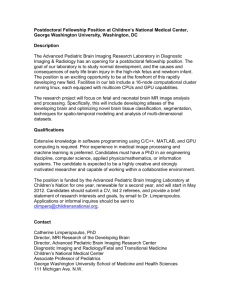Imaging Societies Stakeholders in Quantitative Imaging and Biomarkers as
advertisement

The Radiological Society of North America Founded in 1915 Imaging Societies as Stakeholders in Quantitative Imaging and Biomarkers Quantitative Imaging & Imaging Biomarkers: -Complex Challenges -Extraordinary Opportunity -Multiple Stakeholders Patients Clinicians Clinical researchers Imaging professionals Imaging societies Imaging equipment manufacturers Pharmaceutical, biologics manufacturers Software developers NIH– Roadmap; Biomarkers Consortium FDA– Critical Path Initiative CMS & healthcare insurers Healthcare purchasers .org Why? Because… …of what the future will demand of us …there is much we can do to advance the field .org Who are the imaging organizations and what has all this to do with them (us)? 50 imaging organizations Diverse interests Academy of Radiology Research AMA Section Council on Radiology American Association for Women Radiologists American Alliance of Academic Chief Residents in Radiology American Association of Physicists in Medicine American Board of Nuclear Medicine American Board of Radiology American Brachytherapy Society American College of Medical Physics American College of Nuclear Medicine American College of Nuclear Physicians American College of Radiology American College of Radiology Council American College of Radiology Private Practice American College of Radiology Residents American Institute of Ultrasound in Medicine American Osteopathic College of Radiology American Radium Society American Roentgen Ray Society American Society for Therapeutic Radiology and Oncology American Society of Clinic Radiologists American Society of Emergency Radiology American Society of Head and Neck Radiology American Society of Interventional & Therapeutic Neuroradiology American Society of Neuroradiology Association of Program Directors in Radiology Association of Residents in Radiation Oncology Association of University Radiologists Association of VA Radiologists Canadian Association of Radiologists Council on Cardiovascular Radiology and Intervention of the AHA Fleischner Society International Skeletal Society International Society for Magnetic Resonance in Medicine National Medical Association, Section on Radiology North American Society for Cardiac Imaging Radiological Society of North America Radiological Society of North America R & E Foundation Society for Computer Applications in Radiology Society for Pediatric Radiology Society for the Advancement of Women's Imaging Society of Breast Imaging Society of Computed Body Tomography and Magnetic Resonance Society of Gastrointestinal Radiologists Society of Interventional Radiology Society of Nuclear Medicine Society of Radiologists in Ultrasound Society of Skeletal Radiology Society of Thoracic Radiology Society of Uroradiology Imaging Organizations All 50 share a common interest: The use of imaging in clinical medicine And a common objective: Safe, high-quality, personalized care Minimum effort: respond to change Ideal: collaborate and direct change Powerful Forces of Change Data deluge, workflow issues Genomics, personalized medicine Healthcare quality & safety movement Maintenance of Certification Pay-for-performance PACS, teleradiology, imaging technology, market forces commoditization Snapshot: Diagnostic Radiology Training & Practice Images courtesy of Janet Strife, M.D. 187 N. American training programs Apprenticeship-like environments Qualitative interpretation Pattern recognition Few quantitative methods Not imaging-science intensive Lack of research culture Few qualified trained clinical trialists Change Deming – “You don’t have to [change]. Survival is not compulsory.” Darwin – “It’s not the strongest of the species that survive, nor the most intelligent, but the one most responsive to change.” Data Explosion 1996 1998 2001 2005 HiSpeed Cti LightSpeed QX/I LightSpeed Ultra LightSpeedVCT 10mm 2.5mm 1.25mm .625mm 30 slices 120 slices 240 slices 480 slices “It is like trying to find a smaller and smaller needle in a larger and larger haystack.” Slide courtesy of Wesley Turner, Ph.D., formerly of GE Global Research, currently in Research at Kitware, Inc. Data Explosion And this is just the anatomic imaging data of contemporary imaging practice. Let’s not forget the functional and molecular imaging data that will soon underpin both clinical trials and practice. Data Explosion = Opportunity for Quantitative Approaches… in Detection, Dx, Response to Tx, IGI, but… …full range of validated software tools will be needed Personalized Medicine Exploiting the Human Genome in Health & Disease Personalized Medicine Exploiting the Human Genome in Health & Disease Molecular signatures of disease Targeted Tx; Measurement of response Detection; Diagnosis; Disease quantification; Localization; Prediction of response to Tx Molecular imaging to play a key role Quantitation essential to clinical trials, practice To add value, clinical imagers must embrace and master quantitative methods Targeted Drugs to Treat Cancer CANCER DRUG ACTION Colorectal cancer Bevacizumab (Avastin) Cetuximab (Erbitux) Irinotecan (Campto) Capecitabine (Xeloda) Oxaliplatin (Eloxatin) Angiogenesis inhibitor EGFR inhibitor Topoisomerase inhibitor DNA/RNA synthesis inhibitor DNA/RNA synthesis inhibitor Multiple Myeloma CML, GIST Bortezomib (Velcade) Proteasome inhibitor Imatinib mesylate (Gleevec, Glivec) Tyrosine kinase inhibitor Lung cancer Geftinib (Iressa) Erlotinib (Tarceva) EGFR tyrosine kinase inhibitor EGFR tyrosine kinase inhibitor Breast cancer Exemestane (Aromasin) Letrozole (Femara) Anastrozole (Arimidex) Tamoxifen Fulvestrant (Faslodex) Trastuzumab (Herceptin) Aromatase inhibitor Aromatase inhibitor Aromatase inhibitor Estrogen receptor antagonist Estrogen receptor antagonist Anti-Her2/neu monoclonal Ab FES (18F-Estradiol) Uptake on PET Predicts Response of Breast CA to Hormonal Therapy Example 1 • Recurrent sternal lesion Pre-Rx Post-Rx Excellent response after 6 wks Letrozole • ER+ primary • Recurrent Dz strongly FES+ Example 2 FES • Newly Dx’d breast cancer • ER+ primary • FES-neg bone mets Univ of Washington FDG FDG No response to several different hormonal Rx’s Quon, A. et al. J Clin Oncol; 23:1664-1673 2005 DCE-MRI predicts response of Colorectal CA to Vatalanib DCE MRI: Patient with Colorectal CA Treated with PTK 787 (Vatalanib)1 Baseline Day 2 Ki dropped from 100% baseline to: 31% on day 2 34% at end cycle 1 Ki: bi-directional transfer constant 15% at end cycle 2 Thomas et al. EORTC-NCI-AACR 2002. 1VEGF Receptor Tyrosine Kinase Inhibitor How New Imaging Technologies Get Introduced Old paradigm: add newly developed technology to traditional imaging practice Currently: -Molecular & functional measures assuming greater importance -Most radiology departments configured in anatomic/modality sections -Few radiologists involved in imaging science or technology development For imaging professonals to add value to personalized medicine, we will need: Massive culture shift in training and practice To embrace quantitative methods Robust offering of validated software tools Standardized lexicon/ontology such as RadLex Structured reporting (will facilitate, practice, research, QI, coding/billing) To participate in clinical trials Standardize protocols Interoperable imaging hardware across sites, practices, clinical trials How will imaging specialists add value to personalized medicine? Pre-Tx sorting of responders & non-responders Rapid assessment of response to initiated Tx Verifying Tx targeting in “theragnostics” Measuring response to Tx Rendering prognostic information Imaging clinical trialists will provide the quantitative data that will underpin regulatory approval of new biologics and pharmacotherapeutics Apply quantitative methods in IGI Quality & Safety Movement in U.S. Healthcare INSTITUTE OF MEDICINE 2001: Crossing the Quality Chasm Today’s U.S. Healthcare System “Healthcare system fails to translate knowledge into practice.” “A highly fragmented delivery system results in poorly designed care and duplication of services.” Health Care Spending as a Share of U.S. Economic Output Rising Steadily Overall, About Half of Recommended Care Is Delivered About 50-54% of care that Americans receive… Care that meets quality standards …is care that is actually recommended McGlynn EA, Asch SM, Adams J, et al. The quality of health care delivered to adults in the United States. N Engl J Med 2003;348:2635-45. INSTITUTE OF MEDICINE Calls for fundamental change in aims, with delivery of healthcare that is: 2001 Safe Effective Patient centered Timely Efficient Equitable Assuming Responsibility for Patient Safety & Healthcare Quality Stakeholders Taking Action JCAHO: National Patient Safety Goals NCQA: Accred., Certification, Physician Recognition NQF: List of 30 safe practices IOM: Top 20 national healthcare priorities IHI: 100,000 Lives Campaign (now 5 million) National Patient Safety Foundation (& other) State medical boards: sentinel event reporting Payors (including CMS): P4P, PQRI Assuming Responsibility for Patient Safety & Healthcare Quality Radiology Leadership Groups Taking Action Specialty & subspecialty society quality committees Journal editors: journal sections, articles on quality Quality programs at society meetings Sun Valley Group: Radiology Quality Summit International Radiology Quality Network (IRQN) Member Boards of ABMS: MOC Programs: Component 4, we strive to improve what we do, not just what we know Technological solutions in quality improvement Computerized Physician Order Entry Scheduling, tracking, workflow software Objective quantitative interpretation with use of validated software Structured reporting, with standardized Lexicon/ontology Software-enabled measurement of report timeliness, accuracy The Radiological Society of North America Founded in 1915 Standards are important Courtesy of R. Gilbert Jost, M.D. Leader in Technology & Standards for Imaging & Healthcare DICOM ® IHE Integrating the Healthcare Enterprise MIRC Medical Imaging Resource Center-software toolkit RadLex® Ontology for Uniform Indexing & Retrieving Image Info -Imaging research databases -Educational materials -Clinical imaging reports .org Leader in Technology & Standards for Imaging & Healthcare Open source software toolkit Acquires image data from modality or PACS De-identifies http / https transfers (encrypted) Organizes transferred data Has query function Now in use in clinical trials*, caBIG *ACCORD, WHIMS, RIDER, CAMP, Other .org Integrating the Healthcare Enterprise An initiative to achieve efficient exchange of healthcare information through implementation of standards Supported widely by healthcare IT and imaging industries Industry reps work with healthcare professionals Create Integration Profiles, guidelines for implementing interoperability standards Participating vendors implement, test and demonstrate products incorporating these solutions Major component of EHR initiative in U.S. Roles for the RSNA in Collaboration with other Imaging Organizations 1. Convener of imaging biomarker stakeholders 2. Forum for scientific presentations on latest science in imaging biomarkers—Annual Meeting 3. Coordinate efforts to reduce measurement uncertainty 4. Sponsor, organize, conduct imaging biomarker methodology workshops 5. Publish proceedings 6. Dedicated annual meeting (“Toward Quantitative Imaging)? 7. As with IHE, facilitate development of consensus stds among industry stakeholders (device, PhRMA, CROs) Roles for the RSNA in Collaboration with other Imaging Organizations 8. 9. Play larger, central role in several related activities: -IRATs -Imaging informatics (eg. caBIG) -UPICTs, similar efforts -Archive development Internationalize the effort 10. In conjunction with NIH: organize, train, qualify clinical trialists, imaging scientists 11. Provide infrastructure, tools to facilitate clinical trials (MIRC, RadLex, IHE’s TCE Profile, other) 12. Establish network or cooperative group of qualified imaging trialists who utilize common standards 13. Participate in the FNIH Biomarkers Consortium



